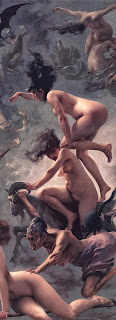The Archaeology of Gatherings
Institute of Technology, Sligo, Ireland
25th to 27th October 2013
Conference Abstract
The Archaeology of Gatherings is a thematic international
conference to bring together a range of speakers from different disciplines
including both academics and professionals. The aim is to explore the material culture and psychology
behind gatherings of people. With
2013 being the year of 'The Gathering' this theme was chosen to examine why
people over millennia have come together, often in large numbers, for religious
assemblies, social interaction, to exchange commodities and ideas, along with
other reasons such as farewells, wakes, political opposition, inaugurations
etc.
Organisers: Sam Moore, Fiona Beglane, Bridget Brennan,
Ursula Garner
Applied Archaeology, Dept of Environmental Science, School
of Science, IT Sligo, Ash Lane, Sligo, Ireland
Contact us at: archaeologyofgatherings@yahoo.com
Programme
Archaeology of Gatherings Programme: IT Sligo, 25-27th
October 2013
Friday 25th October
9:00pm
Informal drinks, Glasshouse Hotel, Sligo
Saturday 26th October
Session 1:
8:30
Registration
9:30
Opening address
9:40
Dr Jonathan Lanman, Institute of Cognition and Culture, QUB:
Ritual and Divergent Modes of Cohesion
10:00
Dr Hans Hognestad, Centre for Cultural and Sports Studies,
Telemark University, Norway:
Identity, power and the sociality of football
10:20
Edel Barry MPhil, Built Heritage Collective Ireland:
Gatherings:
The Archaeology of Railways in Ireland
10:40
Dr Robert Hensey, Archaeological Research Professional:
Crowd-sourcing in the Boyne Valley
11:00
Questions
11:10
Tea/Coffee
Session 2:
11:30
Prof Elizabeth FitzPatrick, NUI Galway:
Shifting Territorial Boundaries and Medieval Assembly Places
11:50
Dr Dominic Bryan, Institute of Irish Studies, Queens
University Belfast:
Public Space and Power – Ritual and Identity in a ‘Shared’
Belfast
12:10
Prof Stuart Tyson Smith, University of California, Santa
Barbara, US:
Colonial Gatherings: The Presentation of Inu in New Kingdom
Egypt and the British Imperial Durbar, a Comparison
12:30
Stephen Dixon, MSc, IT Sligo:
Archaeological and anthropological aspects of 'forced
gathering' from within the Jewish Holocaust
12:50
Questions
1:00
Lunch with demonstration by Ancient Music Ireland from 1:30
2:15
Keynote Speaker:
Prof. Clark McPhail University of Illinois,
Urbana-Champaign, US:
The Life Course of Temporary Gatherings
2:55
James Bonsall, University of Bradford, Earthsound
Archaeological Geophysics, Dr. Chris Gaffney, University of Bradford, Prof.
Vince Gaffney, University of Birmingham, Heather Gimson, Earthsound
Archaeological Geophysics, Robert M. Chapple, William Dunlop Archaeological
Photographic Archive, Irish Radiocarbon and Dendrological Dates, Wolfgang
Neubauer, Ludwig Boltzmann Institute for Archaeological Prospection and Virtual
Archaeology, University of Vienna:
Tonight we’re going party like it’s 1985! The Archaeology of
Festivals in Geophysical Data
3:15
Dr Edel Bhreathnach, Discovery Programme:
Medieval Gatherings
3:35
Questions
3:45
Tea/Coffee and Poster Session
Session 4:
4:25
Dr Stefan Bergh, Dept of Archaeology, NUI, Galway:
Meeting at the edge – Turlough Hill as a place of
prehistoric assembly
4:45
Michael MacDonagh, NRA:
Under the same night sky – the architecture and meaning of
Bronze Age stone circles in mid-Ulster
5:05
Patrick Gleeson MA, UCC:
Gathering the Nations: Kingdoms, Communities and Civil
Society in Early Medieval Ireland
5:25
Questions
5:35
Close of Day
Session 5:
9:30
Dr Una MacConville, Visiting Fellow, Centre for Death and
Society, University of Bath, UK:
Gatherings on the ‘Far side banks of Jordan’
9:50
Dr Louise Nugent, Independent Scholar:
Gatherings of faith: Pilgrimage in medieval Ireland
10:10
Pádraig Meehan, Independent Scholar:
'Cargo Cults' in the Pacific; Irish Neolithic parallels?
10:30
Dr Candace Weddle, Assistant Professor of Art History
Anderson University South Carolina USA:
Blood, Fire and Feasting: The Sensory Experience of
Greco-Roman Sacrifice
10:50
Questions
11:00
Tea/Coffee
Session 6:
11:20
Keynote Speaker:
Prof Mike Parker-Pearson, Institute of Archaeology,
University College London:
Gatherings at Durrington Walls and Stonehenge
12:00
Dr Richard Madgwick, Cardiff University:
A Passion for Pork: Feasting in southern Britain from the
Neolithic to the Iron Age
12:20
Dr Julia E. M. Cussans, Archaeological Solutions Ltd,
Stephen J. Dockrill, University of Bradford, Ian Armit, University of Bradford,
Julie M. Bond, University of Bradford, Jo T. McKenzie, University of Bradford:
 ‘You’re invited
to a party, don’t turn up legless’: case studies in feasting and community
gatherings in Iron Age Scotland.
‘You’re invited
to a party, don’t turn up legless’: case studies in feasting and community
gatherings in Iron Age Scotland.
12:40
Questions
12:50
Closing address
1:00
Poster prize presentation
1:05
Close of Conference followed by unofficial field trip



























